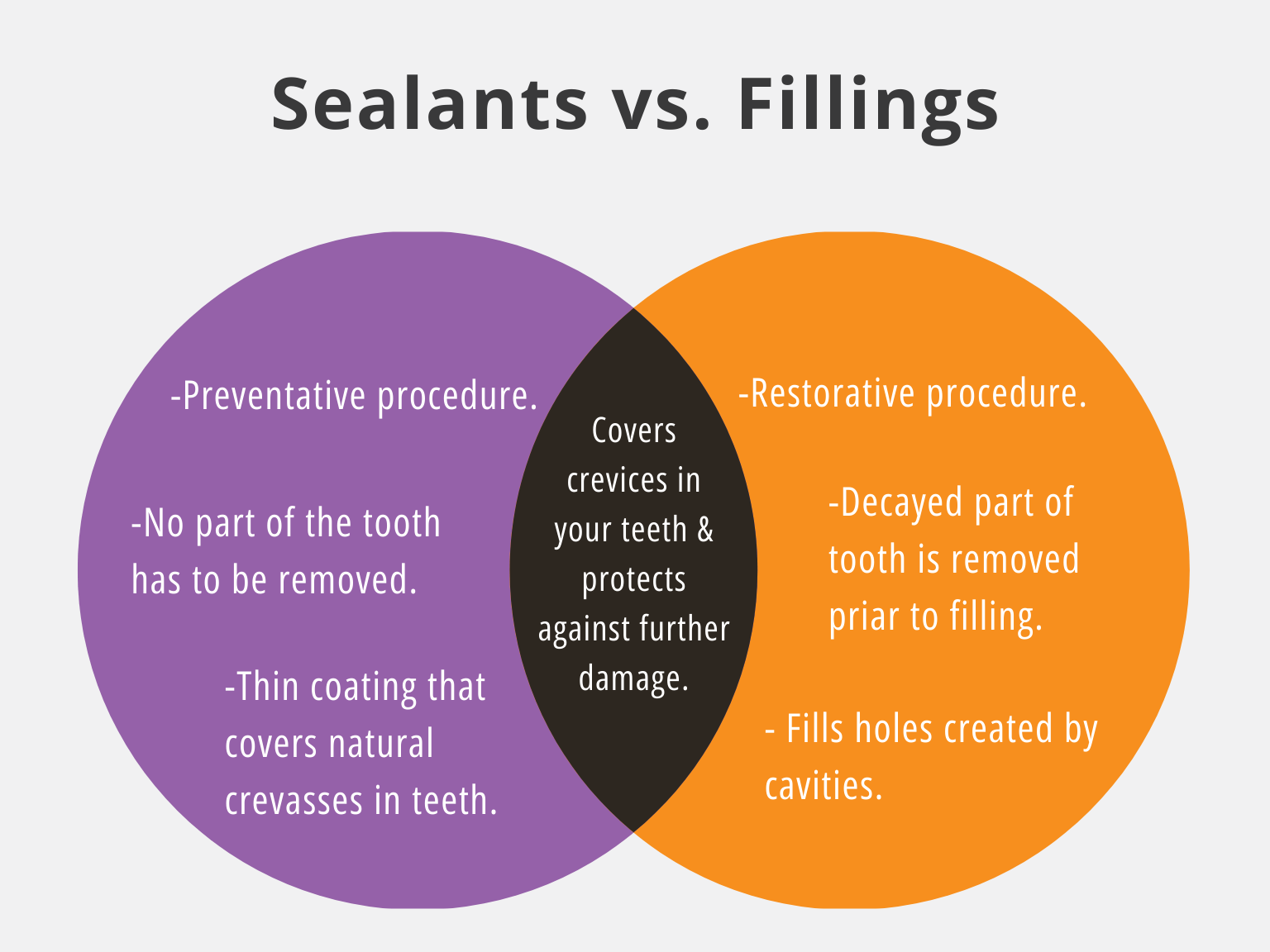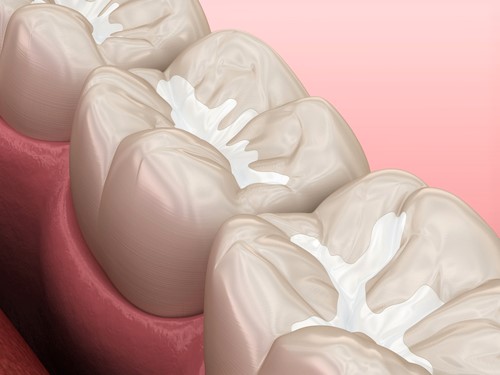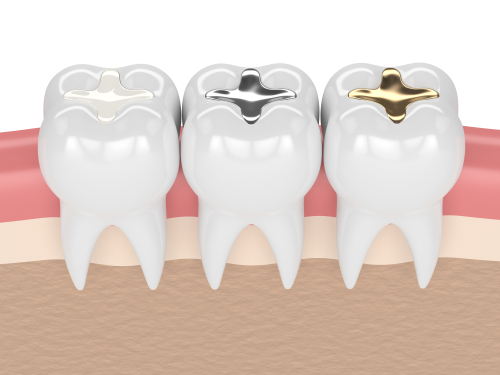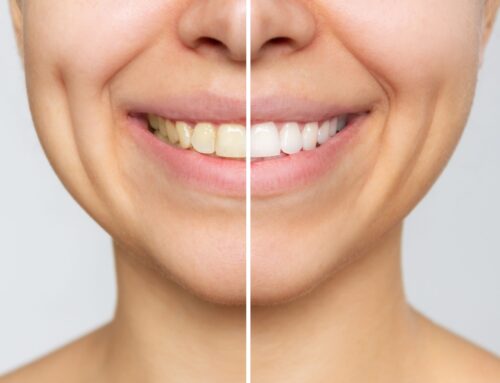Sealants vs. Fillings: What’s the Difference?
Outside of routine cleanings, dentists provide a wide range of preventative and restorative treatments that can help keep your teeth in tip-top shape. It’s essential to go in for regular dental checkups and cleanings to ensure you’re doing everything possible for your oral health.
According to the ADA, it’s estimated that about 91% of Americans over the age of 20 have had cavities at some point in their lives. So, although it may seem scary to suddenly spot a small hole in your tooth, keep in mind that cavities are very common and are certainly not the end of the world. The important thing is to make an appointment with your dentist as soon as you notice something off.
Today, we will discuss two of the most common procedures in dentists’ offices – Sealants and Fillers. Both of these are minor dental procedures that are usually relatively quick and straightforward, with little to no recovery time.
Although a good dentist should be able to talk you through both procedures and recommend the best course of action, being informed is still a good idea. This will help you make the best choice for you and your child’s oral health. Hopefully, by the end of today, you’ll be able to discern whether filling or sealant is the best course of action for your child’s teeth. So without further ado, let’s start with some basics.
Dental Sealants
Sealants are a preventive treatment applied to premolars and molars with deep crevices to reduce the risk of tooth decay. Bacteria like these deep grooves because they can hide in them and stay safe from toothbrushing. The longer the bacteria live in these grooves, the more plaque they create, which increases the risk of cavities.
Beyond caring for your teeth daily, getting a sealant makes it easier to brush away the bacteria. With fewer bacteria on your teeth, less plaque acid will build up on the enamel surface of your teeth. So, you can reduce your child’s risk of cavities with a dental sealant.
Can You See A Sealant?
The sealant material looks like a tooth-colored, plastic coating that protects the tooth from decay when applied to a tooth. During the procedure, your dentist will first clean and prepare your tooth before painting on the sealant. The sealant then settles into your tooth’s natural grooves before your dentist uses ultraviolet light to harden and cure it.
During the final step, your dentist will ensure the sealant completely protects your tooth. After the procedure, your tooth surface will be left smooth, easy to clean, and protected from decay.
How Long Do Sealants Last On Your Teeth?
Sealants are most effective for up to two years after application. Although they may last longer than that, they may begin wearing down and need to be replaced.
Are Dental Sealants Worth It?
According to the CDC, children with sealants have almost 3 times fewer cavities than children without sealants.
Since the sealant coating protects teeth from cavities, this could mean fewer cavity fillings and dentist visits in the long term. Whether or not it’s “worth it” depends on your child’s brushing habits, how prone to cavities they are, and how much your dental provider charges for sealant treatments.
Do Adults Need Dental Sealants?
Adults can also get sealants, although it is typically not necessary. Since adult teeth are much more worn down and have fewer crevices on the surface, sealants are generally not required. Your dentist may recommend this course of treatment if it is a good option for your teeth.
Dental Fillings
Fillings are a restorative treatment that repairs tooth decay damage. In fact, fillings are the most common treatment for symptoms of tooth decay, such as cavities. This procedure allows dentists to fill in the holes created by tooth decay.
When you go in to receive a dental filling, your hygienist will clean your teeth before the procedure begins. The area being filled will then be numbed before your dentist removes the decay with a dental drill. Your dentist will prepare the filling material with the decay removed and the tooth prepped.
What Are The Different Types Of Dental Fillings?
- Composite Fillings: At Snodgrass-King Dentistry offices, we offer both composite and amalgam fillings. Composite fillings are made with tooth-colored material made from porcelain. So, if you want a more natural-looking smile, composite fillings might be the right option for you.
- Amalgam Fillings: Amalgam fillings, on the other hand, are made of silver. Amalgam fillings may not look the prettiest, but they do last longer than any other type of filling.
- Ceramic Fillings: Although one of the pricier options, ceramic is an excellent material that hits both durability and aesthetics, and will probably outlast a composite filling.
- Gold Fillings: Gold fillings are not as common as they once were, but are still used for back tooth fillings. These types of fillings are typically known for their longevity and strength.
Be sure to talk to your dentist before your procedure to choose the proper dental filling.
Is Dental Filling Painful?
Although they may sound scary, tooth filling procedures are rarely painful at all. Since tooth fillings don’t usually involve the gums or nerves, there is minimal discomfort associated with the procedure. Just in case, however, your dentist will usually numb the area before starting the procedure.
How to Minimize Tooth Sensitivity After a Filling
To lower the risk of experiencing tooth sensitivity after a filling, be sure to do the following:
- Avoiding extremely hot or cold foods can help prevent sensitive teeth
- Brush teeth gently in the days following a filling to avoid irritation to the treated tooth
- Try chewing on the other side of the mouth that was not treated, if possible, this can help with putting less pressure on the filled tooth
Finishing The Procedure
You should know that on top of removing the decay from your tooth, your dentist might also have to remove any previous dental restoration. Next, the cavity is cleaned out and the material is prepared. Whether you choose an amalgam or a composite filling, your dentist will shape the material to your tooth and thoroughly fill the cavity.
Finally, the material is cured and hardened using ultraviolet light, like the sealant process. After the material has hardened, the bite is adjusted and corrected using a handpiece.
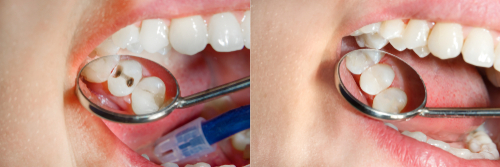
How are Dental Sealants and Dental Fillings Similar?
Both treatments fill the tooth grooves and provide a protective shield to the enamel. The processes of the treatments are similar, as they are less invasive than surgery, and at most require a dental drill and some ultraviolet light.
How are Dental Sealants and Dental Fillings Different?
Although the general purpose of the two procedures is similar (to fill crevices in your teeth), the main difference between the two is that one procedure is preventative, and the other is restorative. Sealant is used to cover the surface of a tooth to prevent future cavities. Fillers, on the other hand, are used to repair cavity holes already created in the surface of a tooth.
Other differentiating factors are the longevity of the treatments, the amount of modification to the tooth, and the cost. The average life expectancy of a filling can be as long as ten years, while a sealant can last as little as two years.
Another difference lies in how these procedures are performed. During a filling, the natural tooth structure is modified, which means that the decayed part of the tooth is removed and then filled. In contrast, a dental sealant only fills in the natural grooves of the tooth without changing the structure.
Should I Choose Dental Sealants or Dental Fillings for My Child?
Whether you should choose filler or sealant depends on your child’s age and specific dental needs. Since sealants are typically used as a preventative procedure, while fillers are a restorative one, both treatments can be combined. Fortunately, a good pediatric dentist can help you make a decision. Feel free to ask your dental provider any questions you have and for their expert opinion regarding what’s best for your child’s teeth.
What are the Alternatives to a Filling or Sealant?
There are alternatives to a filling or sealant to discuss with your dental provider; these alternatives include:
- Inlays and Onlays: Made from porcelain, gold, or composite resin, these custom-made devices are cemented into teeth with cavities or damage.
- Dental Crowns: Dental crowns cover a weakened or damaged tooth to prevent further complications. Typically, dental crowns are used when fillings are not enough to restore the structure of a tooth.
- Dental Bondings: Dental bondings are quick procedures to treat chips and cracks and can help treat smaller cavities. Dental bonding is a tooth-colored resin only applied to the tooth’s surface.
How Much Does a Filling or Sealant Cost?
First, most dental insurance companies help cover most of the cost of a filling or sealant. However, this will depend on the insurance coverage and the paramount need for a filling or sealant. It is always best to connect with your insurance provider to know your coverage prior to your filling or sealant appointment!
On average, a filling, such as an Amalgam filling, can cost anywhere from $190 to $300, while sealants can range from $30 to $60 per tooth.
Looking for a Dentist in Tennessee?
At Snodgrass-King Dental, we’ve provided dental care for parents and their children for over 25 years. Throughout all these years, we’ve always valued our patients’ health and happiness above all else.
We currently offer services across four different office locations throughout Middle Tennessee (Mt. Juliet, Murfreesboro, Franklin, and Spring Hill). Our areas of expertise include pediatric dentistry, family orthodontics, and adult dentistry. This means that no matter who’s got a toothache in your family, we’ve got you covered! You could even schedule your appointment at the same time as your child’s.
We look forward to hearing from you.


